The King’s Plate was inaugurated, with royal blessing, on Wednesday, June 27, 1860, at the Carleton track in Toronto, located in bucolic surroundings near what is now the traffic-strangled southwestern corner of Keele and Dundas streets.
Sir Casimir Gzowski and Thomas Patteson were the two men who brought the race into close association with Buckingham Palace. Back on April 1, 1859, the Toronto Turf Club petitioned Queen Victoria to grant a Plate for a race in Ontario. The president of the club was Gzowski, a distinguished engineer whose father had been a Polish officer in the Russian Imperial Guard.
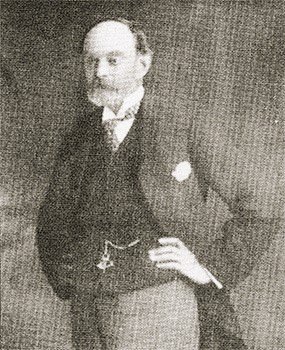
the Englishman who created the Ontario Jockey Club
There is no reason to believe that Queen Victoria was a wild-eyed devotee of horse racing. However, Her Majesty granted the petition of the little turf club in the boisterous Upper Canada community (the population of Toronto was 44,425) and offered as an annual prize, “a plate to the value of Fifty Guineas.”
Canadian horse-racing had fallen on evil days in 1881, when Joseph Duggan, owner of the Woodbine race course, decided that the only person who could save the situation was Toronto’s postmaster T. C. Patteson, a remarkable man who was recovering from the financial disaster of funding the old Toronto Mail. When he died, the Toronto World described him as “the man of the most distinct personality ever known to Toronto and probably to all Canada.”
Patteson was a paradox – a courtly Etonian and Oxonian who insisted upon transplanting the gracious living of upper class England to rowdy Toronto although for personal protection, he carried a pair of brass-knuckles in his jacket pockets. (Twice, he was knocked senseless by footpads in the Toronto streets.)
Patteson attacked the racing problem with his customary vigour. He called the formation meeting of The Ontario Jockey Club at the Queen’s Hotel in June, 1881. Sir Casimir promptly subscribed $500 and attempted to leave the chair, saying, “There, that’s all I expect that you want of me.”
But Patteson had other plans which he confided to Sir Casimir. They agreed that horse racing would be established for all time as a Canadian institution – not alone as a sport – if a member of the Royal Family could be persuaded to attend the races at Woodbine. In his personal writings, Patteson envisioned the day “when the Queen herself would be present for the running of The Queen’s Plate.”
The plot was hatched guilefully. The incumbent Governor-General of Canada was the Marquis of Lorne. The Marchioness of Lorne was Princess Louise, daughter of Queen Victoria. In his capacity as aide-de-camp to the Queen, Sir Casimir invited the Lornes to be his house guests in Toronto. Remarkably, their visit coincided with the spring racing meeting at Woodbine. Remarkably, too, they agreed to accompany their host to the races.
It was perhaps, typical of Patteson that, writing of the event under a pen-name in The Mail, he remarked testily that “it was unfortunate that Her Royal Highness delayed the start of the racing by being 15 minutes late.”
Sir Casimir and Mr. Patteson had turned the trick. Canadian racing was established as “the sport of royalty”.
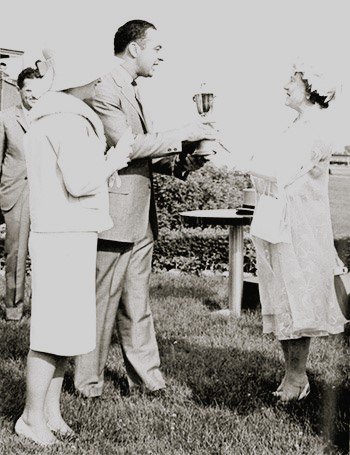
Royal Visits
King George VI
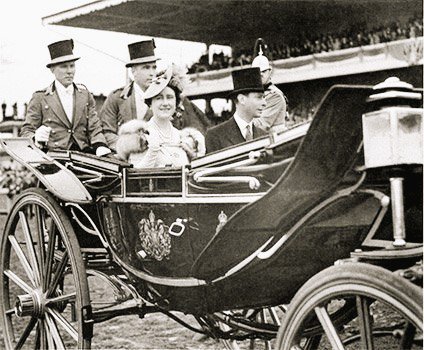
King George VI and Queen Elizabeth established a royal visit tradition, charming the Old Woodbine crowd at the 1939 Plate, won by Archworth, owned by C. George McCullagh, trained by Mark Cowell and ridden by Denny Birley.
Queen Elizabeth II
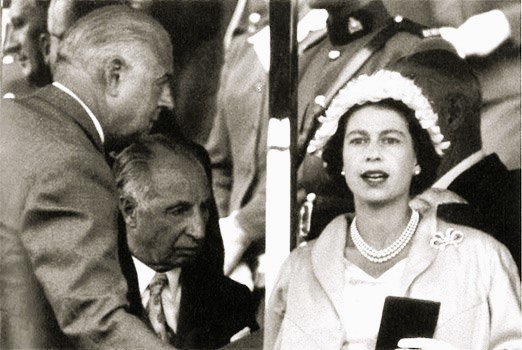
King George VI and Queen Elizabeth established a royal visit tradition, charming the Old Woodbine crowd at the 1939 Plate, won by Archworth, owned by C. George McCullagh, trained by Mark Cowell and ridden by Denny Birley.
In 1973 Queen Elizabeth II and Prince Philip witnessed their second Queen’s Plate, attending the 114th running, won by Royal Chocolate. The winner was owned by Stafford Farms, trained by Gil Rowntree and ridden by Ted Colangelo.
In 1997 Queen Elizabeth II and Prince Philip were on hand to witness their third Queen’s Plate. The 138th running was won by Frank Stronach’s Awesome Again. The son of Deputy Minister was trained by David Hofmans and ridden to victory by Mike Smith.
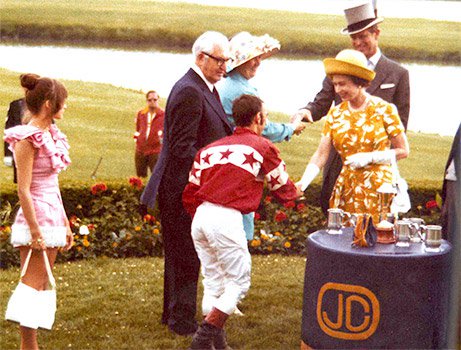
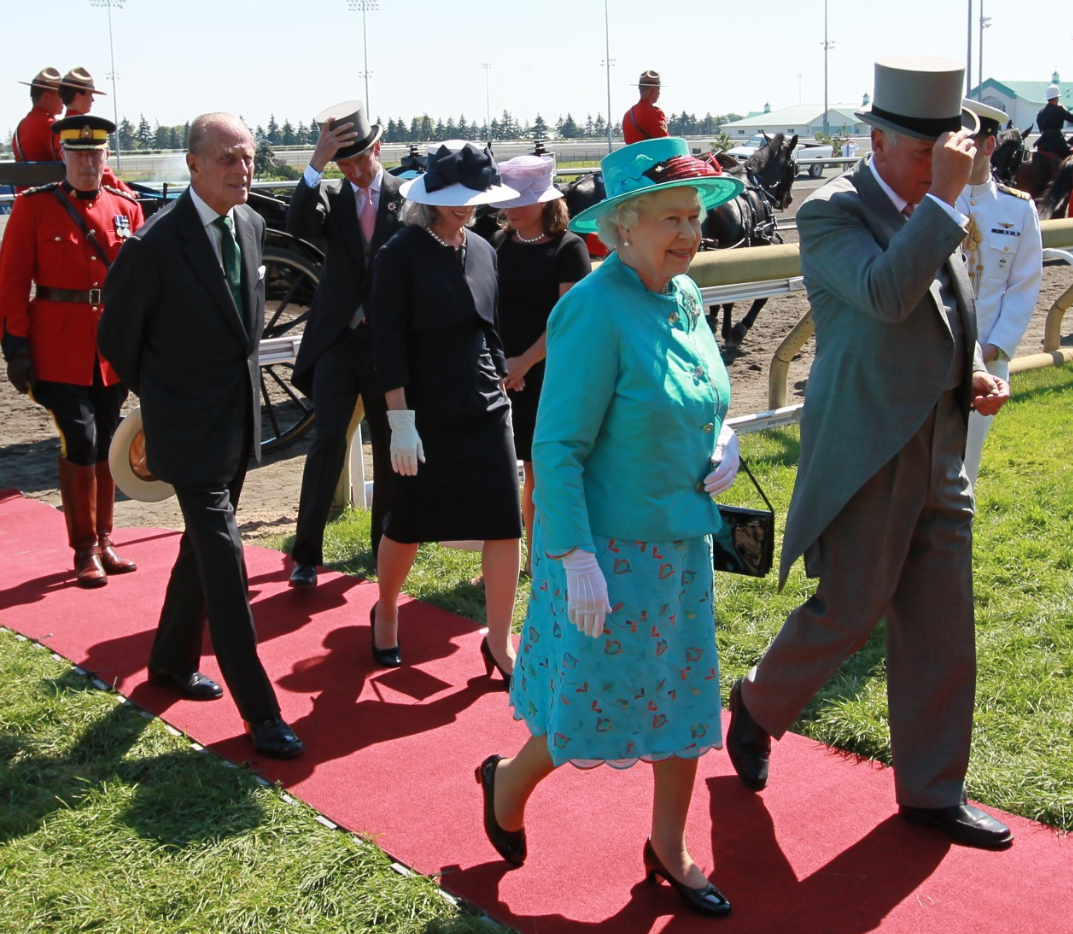
King George VI and Queen Elizabeth established a royal visit tradition, charming the Old Woodbine crowd at the 1939 Plate, won by Archworth, owned by C. George McCullagh, trained by Mark Cowell and ridden by Denny Birley.
In 1973 Queen Elizabeth II and Prince Philip witnessed their second Queen’s Plate, attending the 114th running, won by Royal Chocolate. The winner was owned by Stafford Farms, trained by Gil Rowntree and ridden by Ted Colangelo.
Queen Elizabeth the Queen Mother
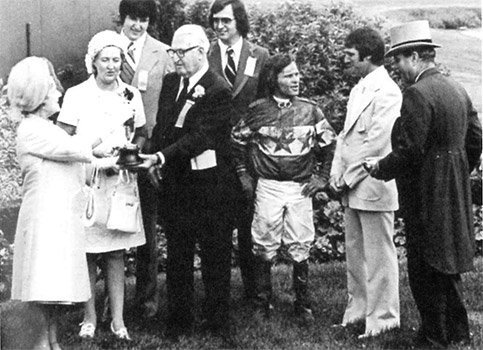
In 1962 Queen Mother Elizabeth attended the 103rd running won by Flaming Page, owned by Mr. and Mrs. E. P. Taylor, trained by Horatio Luro and ridden by Jim Fitzsimmons.
Again, in 1965, Queen Mother Elizabeth attended the 106th running won by Whistling Sea, owned by Paul Olivier of Calgary and ridden by Tak Inouye. Whistling Sea was the first Western-bred horse to win The Plate.
In 1974 Queen Mother Elizabeth attended the 115th running of The Queen’s Plate, her fourth official visit to an Ontario race track. The Queen’s Plate was won by Amber Herod, owned by Stafford Farms and trained by Gil Rowntree. He was ridden by Robin Platts.
Queen Mother Elizabeth made her fifth visit to The Queen’s Plate in 1979. This time she attended the 120th running of the three-year-old classic and watched Kinghaven Farms’ Steady Growth defeat Windfields Farm’s Bold Agent over a sloppy track.
In 1981 The Queen Mother congratulated Mr. and Mrs. Jack Carmichael, trainer Jim Bentley and jockey David Clark after Fiddle Dancer Boy eked out a nose decision.
Her Majesty Queen Elizabeth The Queen Mother made her sixth appearance at Woodbine in 1985. She made the presentation to Charles Taylor, of Windfields Farm, whose brilliant filly, La Lorgnette won handily. La Lorgnette is the second filly in history to capture both the Canadian Oaks and The Queen’s Plate.
In 1989 Her Majesty Queen Mother Elizabeth celebrated the 50th anniversary of her first visit to Toronto and the Royal Race. The Queen Mother presented the Gold Cup to With Approval’s proud owner, Mr. “Bud” Willmot.
Other Royal Visits
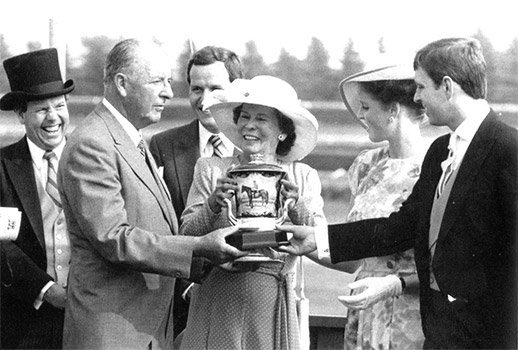
In 1987, Their Royal Highnesses, The Duke and Duchess of York Prince Andrew and Lady Sarah witnessed the 128th running of The Queen’s Plate.
Earl of Westmorland, Master of the Queen’s Horse, was on hand in 1978 to witness jockey Sandy Hawley and Regal Embrace stride under the wire first in the 119th edition of The Queen’s Plate. Trainer Mac Benson and owner E.P. Taylor met the regal ambassador in the winner’s circle after the race.
In 1987, Their Royal Highnesses, The Duke and Duchess of York Prince Andrew and Lady Sarah witnessed the 128th running of The Queen’s Plate. In 2002, Their Royal Highnesses Prince and Princess Michael of Kent were the first visiting “representatives” of the Monarchy to witness a Queen’s Plate since 1989 (Queen Elizabeth II and Prince Philip were at Woodbine in 1997). They watched T J’s Lucky Moon cross the wire first in the 143rd edition of the Royal Race
Guest Since 1973
past winners
| Year | Horse | Jockey | Trainer | Owner | Time |
|---|---|---|---|---|---|
| 2024 | Caitlinhergrtness | Rafael Manuel Hernandez | Kevin Attard | Siena Farm LLC and WinStar Farm LLC | 2:03.45 |
| 2023 | Paramount Prince | Patrick Husbands | Mark Casse | Michael Langlois and Gary Barber | 2:01.93 |
| 2022 | Moira | Rafael Hernandez | Kevin Attard | X-Men Racing, Madaket Stables LLC, SF Racing LLC | 2:01.48 |
| 2021 | Safe Conduct | Irad Ortiz Jr. | Phillip Serpe | WellSpring Stables | 2:02.85 |
| 2020 | Mighty Heart | Daisuke Fukumoko | Josie Carroll | Lawrence Cordes | 2:01.98 |
| 2019 | One Bad Boy | Flavien Prat | Richard Baltas | Sayjay Racing | 2:02.98 |
| 2018 | Wonder Gadot | John Velazquez | Mark Casse | Gary Barber | 2:02.26 |
| 2017 | Holy Helena | Luis Contreras | James Jerkens | Stronach Stables | 2:02.87 |
| 2016 | Sir Dudley Digges | Julien Leparoux | Michael Maker | Kenneth and Sarah Ramsey | 2:04.09 |
| 2015 | Shaman Ghost | Rafael Manuel Hernandez | Brian A. Lynch | Stronach Stables | 2:03.45 |
| 2014 | Lexie Lou | Patrick Husbands | Mark E. Casse | Gary Barber | 2:03:94 |
| 2013 | Midnight Aria | Jesse M. Campbell | Nicholas Gonzalez | Tucci Stables | 2:04.72 |
| 2012 | Strait of Dover | Justin Stein | Danny Vella | Canyon Farms | 2:01.99 |
| 2011 | Inglorious | Luis Contreras | Josie Carroll | Donver Stable | 2:02.63 |
| 2010 | Big Red Mike | Eurico Rosa da Silva | Nick Gonzalez | Terra Racing Stable | 2:04.89 |
| 2009 | Eye of the Leopard | Eurico Rosa da Silva | Mark Frostad | Sam-Son Farm | 2:03.84 |
| 2008 | Not Bourbon | Jono Jones | Roger Attfield | Charles E. Fipke | 2:03.59 |
| 2007 | Mike Fox | Emma-Jayne Wilson | Ian Black | D. Morgan Firestone | 2:05.45 |
| 2006 | Edenwold | Emile Ramsammy | Josie Carroll | Jim & Alice Sapara | 2:05.30 |
| 2005 | Wild Desert | Pat Valenzuela | Robert J. Frankel | Daniel Borislow & Partners | 2:07.37 |
| 2004 | Niigon | Robert Landry | Eric Coatrieux | Chiefswood Stable | 2:04.72 |
| 2003 | Wando | Patrick Husbands | Michael Keogh | Gus Schickedanz | 2:02.48 |
| 2002 | T J's Lucky Moon | Steve Bahen | Vito Armata | Molinaro Stable | 2:06.88 |
| 2001 | Dancethruthedawn | Gary Boulanger | Mark Frostad | Sam-Son Farm | 2:03.78 |
| 2000 | Scatter the Gold | Todd Kabel | Mark Frostad | Sam-Son Farm | 2:05.53 |
| 1999 | Woodcarver | Mickey Walls | Michael Keogh | Gus Schickedanz | 2:03.13 |
| 1998 | Archers Bay | Kent Desormeaux | Todd Pletcher | Melnyk & Bristow | 2:02.10 |
| 1997 | Awesome Again | Mike E. Smith | David Hofmans | Frank Stronach | 2:04.20 |
| 1996 | Victor Cooley | Emile Ramsammy | Mark Frostad | Windways Farm | 2:03.80 |
| 1995 | Regal Discovery | Todd Kabel | Roger Attfield | No. 1 Stable | 2:03.80 |
| 1994 | Basqueian | Jack Lauzon | Daniel J. Vella | Frank Stronach | 2:03.40 |
| 1993 | Peteski | Craig Perret | Roger Attfield | Earle I. Mack | 2:04.20 |
| 1992 | Alydeed | Craig Perret | Roger Attfield | Kinghaven Farms | 2:04.60 |
| 1991 | Dance Smartly | Pat Day | Jim Day | Sam-Son Farm | 2:03.40 |
| 1990 | Izvestia | Don Seymour | Roger Attfield | Kinghaven Farms | 2:01.80 |
| 1989 | With Approval | Don Seymour | Roger Attfield | Kinghaven Farms | 2:03.00 |
| 1988 | Regal Intention | Jack Lauzon | Jim Day | Sam-Son Farm | 2:06.20 |
| 1987 | Market Control | Ken Skinner | Roger Attfield | Kinghaven Farms | 2:03.60 |
| 1986 | Golden Choice | Vincent Bracciale, Jr. | Michael Tammaro | Dick Sanderson | 2:07.20 |
| 1985 | La Lorgnette | David Clark | Macdonald Benson | Windfields Farm | 2:04.60 |
| 1984 | Key to the Moon | Robin Platts | Gil Rowntree | B. K. Y. Stable | 2:03.80 |
| 1983 | Bompago | Larry Attard | John Cardella | Carl Cardella & Partners | 2:04.20 |
| 1982 | Son of Briartic | Paul Souter | Jerry G. Lavigne | Paddockhurst Stable | 2:04.60 |
| 1981 | Fiddle Dancer Boy | David Clark | James C. Bentley | John B. W. Carmichael | 2:04.80 |
| 1980 | Driving Home | William Parsons | Glenn Mangusson | CFCW Racing Stable | 2:04.20 |
| 1979 | Steady Growth | Brian Swatuk | John J. Tammaro, Jr. | Kinghaven Farms | 2:06.60 |
| 1978 | Regal Embrace | Sandy Hawley | Macdonald Benson | Windfields Farm | 2:02.00 |
| 1977 | Sound Reason | Robin Platts | Gil Rowntree | Stafford Farms | 2:06.60 |
| 1976 | Norcliffe | Jeffrey Fell | Roger Attfield | Norcliffe Stable | 2:05.00 |
| 1975 | L'Enjoleur | Sandy Hawley | Yonnie Starr | J. Louis Lévesque | 2:02.60 |
| 1974 | Amber Herod | Robin Platts | Gil Rowntree | Stafford Farms | 2:09.20 |
| 1973 | Royal Chocolate | Ted Colangelo | Gil Rowntree | Stafford Farms | 2:08.20 |
King’s Plate
Timeline
Which Plate? Queen’s or King’s
In a symbolic nod to the reigning Canadian monarch, the race proudly bears the name King’s Plate, a tradition that harks back to Queen Victoria’s gracious donation of the inaugural cup.
In 1860, the Queen’s Plate galloped into history, inaugurating its first race amidst great anticipation and excitement, thus laying the groundwork for a legacy of equestrian excellence. In 1902, the race underwent a brief metamorphosis, donning the title King’s Plate in homage to the new monarch, Edward VII, following the somber passing of Queen Victoria.
Yet, like a steed returning to its familiar path, it gracefully resumed its original identity during the illustrious reign of Elizabeth II (1952–2022). Then, in the heralded year of 2022, with the dawn of Charles III’s reign, the race once again embraced a new era, reclaiming its historical moniker, the King’s Plate, with a renewed sense of vigor and purpose.
King’s plate Oddities
There are ironic notes here and there in connection with The King’s Plate, the annual Gallop for the Guineas. For example, The King’s Plate is not a Plate and the King’s guineas are not guineas. Outside of that, The King’s Plate is indeed the “Gallop for the Guineas.”
The guineas? Minting of guineas was discontinued in England during the reign of George III whose forbear, George I, had instituted the gift of fifty guineas in racing, a tradition that remains though the guineas do not.
About it not being a Plate; King Charles II began awarding silver plates as racing prizes in the seventeenth century at Newmarket, the size of the plate indicating the value of the race. But the practice became outmoded, perhaps as variety was sought in the prize. Other pieces of silver were instituted as awards and then other metals were used. Nowadays, The King’s Plate is actually a gold cup, about a foot high.
Canada’s Oldest Thoroughbred Racing
The King’s Plate (known as the Queen’s Plate from 1860 to 1901 and 1952 to 2022) is Canada’s oldest thoroughbred horse race and the oldest continuously run race in North America, having been founded in 1860. It is run at a distance of 1+1⁄4 miles (2 km) for a maximum of 17 three-year-old thoroughbred horses foaled in Canada.
The race’s name reflects the title of the reigning Canadian monarch, following on Queen Victoria’s donation of the first cup.
As King of Canada, Charles III is patron of the event. Various other members of the Canadian royal family have attended, beginning with John Campbell, Marquess of Lorne, and his wife, Princess Louise, in 1881, when Lorne was serving as governor general of Canada and the couple was touring Ontario.[21] Queen Elizabeth II’s fourth and final visit to the race was in early July 2010.